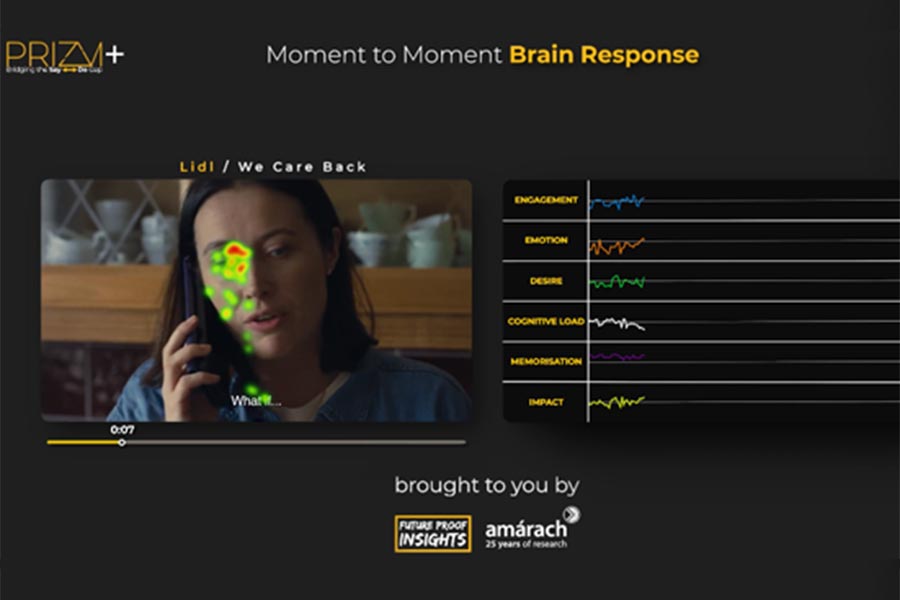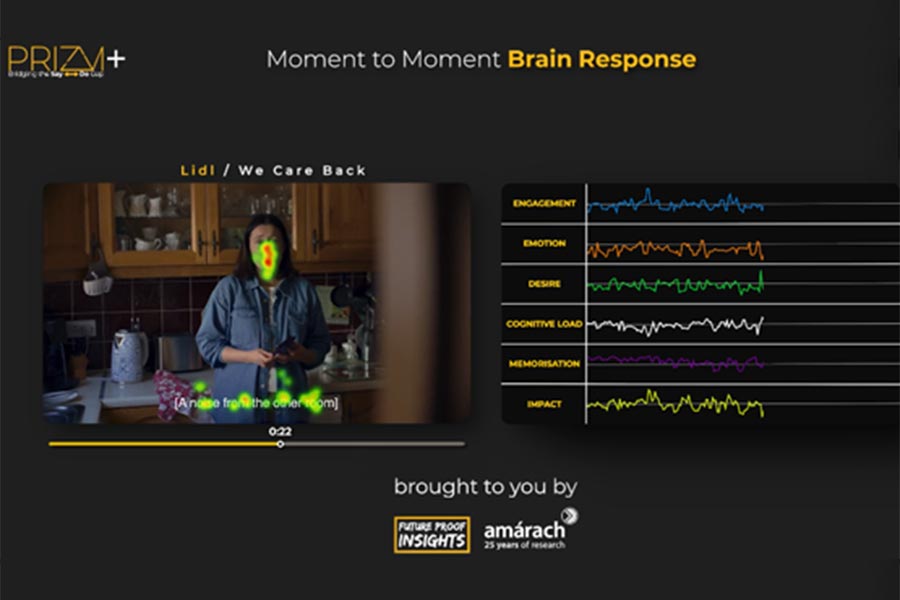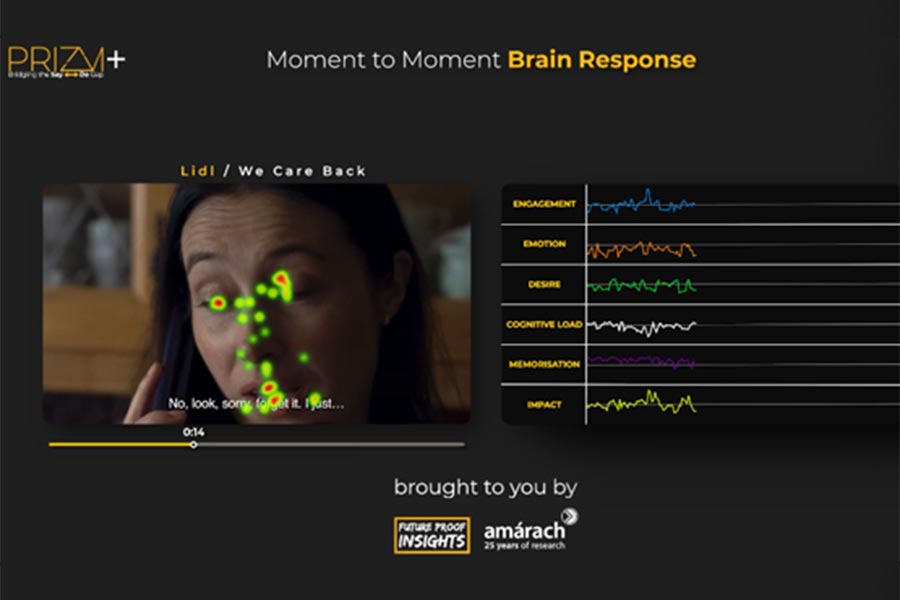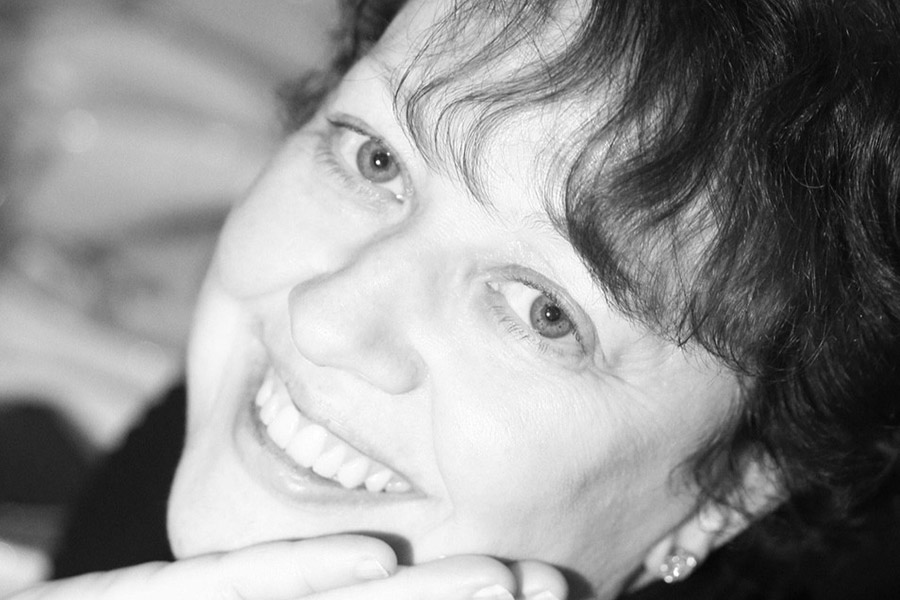Every week, Amárach and Future Proof Insights share exclusive findings from their PRIZM+ ad testing service, showcasing best practice creative advertising in Ireland.
Lidl’s “We Care Back” campaign delivers a quietly powerful message: behind every unpaid carer is someone who needs support too.
The creative doesn’t shout, it shows, offering a window into the quiet, everyday strain of care work, then resolving that tension with a gesture of solidarity.
Told through a series of real, recognisable moments, the ad avoids over-polish. Instead, it draws its emotional power from truth. And according to our data, that truth cuts through.
Neural response data shows the ad performs strongly where it matters most.
Engagement, memorisation, and emotional resonance all spike at key moments.
Cognitive load is managed effectively across the spot, meaning the story is easy to process, even when the emotional stakes are high.
The creative drives impact with peaks at key moments throughout the narrative. The power of this creative is in its peaks.
It’s a confident creative strategy, and it works.
High-Impact Scenes
Scene 2 (4.0s – 8.0s) — "What If..."

As the woman unpacks groceries while on the phone, she starts to say "What if..."—but is interrupted by a background noise. A small, fleeting moment. But the data says otherwise.
Why it works:
This moment grabs attention and holds it. Engagement and impact both spike, while cognitive load stays comfortably in the optimal range.
It’s a familiar scenario, mid-sentence, mid-task, interrupted by something urgent. That subtle tension feels real, and the line "What if..." works because it never resolves.
The brain naturally leans in to complete the thought, which helps the moment stick.
This is a soft example of cognitive closure in action: the audience is nudged to fill in the blanks, which makes them more mentally invested. It’s a smart beat that keeps viewers engaged just as the story begins to build momentum.
This is the kind of subtle framing that helps an audience invest, even before the story’s major beats arrive.
Scene 4 (19.0s – 25.0s) — The Turning Point

The protagonist ends a phone call, clearly drained. Then, a groan from the next room. She pauses, sighs, and softly says "Coming mum."
Why it works:
This is where the narrative pivots, and the brain follows. Motivation and emotional resonance both spike, and memorisation remains high.
Viewers don’t just understand what’s happening, they feel it. Her quiet response carries the emotional weight of the whole campaign.
This is a textbook example of goal contagion, seeing someone persist in the face of pressure makes viewers more likely to align emotionally and cognitively with that goal.
To push performance even further, one creative tweak could help: lose the wide shot just before the line, and hold tighter on her face.
Neuroscience shows that close-ups of facial expressions trigger empathic mirroring, a cognitive effect where the audience mentally simulates what the character is feeling. This helps deepen emotional engagement and improves memory encoding.
Underperforming SceneScene 3 (8.0s – 19.0s) — “I Just Can’t Do This”

Here, the protagonist withdraws from the phone call, overwhelmed. She finally says, "I just can't do this."
Why it underdelivered: This scene is trying to show emotional strain, but it relies almost entirely on the line "I just can't do this" and the protagonist’s facial expression to carry the weight. There’s no physical release or visual cue that helps the viewer process or empathise more deeply.
The brain data reflects this disconnect: viewers are clearly engaged, with cognitive load high, but emotionally, the response remains flat. That suggests the audience is thinking about what's happening rather than feeling it.
What’s missing here is the kind of emotional punctuation we see elsewhere in the ad, a groan, a helping hand, a change in light or tone.
A more symbolic or physical shift might have delivered the emotional payoff the scene is aiming for. Without it, the audience registers the pressure, but doesn’t fully connect to the character’s moment of overwhelm.
A creative adjustment, either in pacing or framing, could turn this into a key emotional hinge in the story.
Category Attribution as a vehicle for Brand Attribution
The ad opens with a woman coming home from the shops, a small detail, but a meaningful one. It signals the category almost instantly. Before a logo appears or a tagline is heard, the audience has already anchored the story in the world of grocery and retail.
This kind of early framing does a lot of heavy lifting. It shapes how the viewer processes everything that follows, priming them for the idea that this is a Lidl ad, even if the brand isn’t named until the end.
Could that link be strengthened further? Possibly. Subtle brand cues earlier in the film, such as a carrier bag, a passing store reference, a distinctive brand colour, would reinforce attribution without undermining the tone.
But even without them, the category framing sets the stage. By the time Lidl's logo appears, the audience is ready to make the connection. The end card drives it home, but the groundwork has already been laid.
Behavioural Impact (COM-B Framework)
The behavioural response matches the neural one: this ad connects.
Motivation is particularly strong, especially among women aged 35–54. That’s not surprising; it speaks directly to lived realities.
These viewers aren’t just observing; they see themselves, or someone they know. That reflective relevance powers belief in the message.
Capability is also high. The message is clear, and the role Lidl is playing is well understood. There’s no confusion about what this is or who it’s for.
The only softer spot is Opportunity. While the ad positions Lidl as a supporter of carers, it stops short of prompting viewers to do anything.
That’s a common trait in cause-driven work; it aims to resonate, not convert. But adding even a subtle call to action (a prompt to share, support or learn more) could convert emotional alignment into behavioural follow-through.
The takeaway? The ad earns belief. It just needs a nudge to turn belief into action.
What Marketers Can Learn
Lidl’s “We Care Back” is a strong example of emotionally-led, purpose-driven advertising that lands. It connects with a specific, often invisible audience and tells their story in a way that is recognisable, authentic, and respectful. It’s also a reminder that empathy is powerful, but it works best when it’s anchored to brand clarity.
Here’s what marketers can take away:
- Set the frame early: The opening scene subtly places us in a retail context. This early category signal helps the brain process everything that follows as part of a brand story, even before the logo appears. Framing matters.
- Let tension do the work: The ad’s most effective scenes aren’t flashy, they’re familiar. A line left unfinished, a sigh before a task. These are everyday stress signals viewers recognise in themselves. The brain responds with attention and emotional memory.
- Close-ups matter: We simulate what we see. Tight shots on facial expressions allow viewers to mirror emotion, a process called empathic mirroring, which increases emotional resonance and memorability.
- Plant the brand sooner: Emotional connection is powerful, but it doesn’t always equal recall. A few more brand cues earlier in the story, packaging, store reference, tone of voice, could reinforce attribution without losing tone.
- From resonance to action: The ad scores high on motivation and message clarity, but lower on opportunity. A subtle call to action could convert that emotional buy-in into behaviour.
In short, marketers should treat emotional storytelling not just as a vehicle for connection, but as a structure for memory. When the right story is paired with the right signal, the brain does the rest.
For more insights from PRIZM+ on how neuroscience drives advertising impact, visit: https://www.futureproofinsights.ie/prizm-plus/










